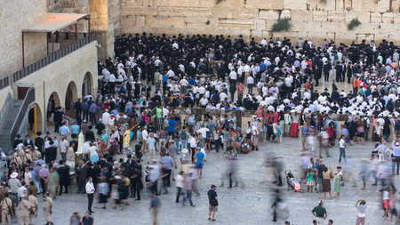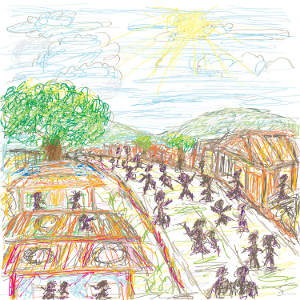Why do we meet together on Shabbat?

By Jonathan Allen, Wednesday 31st December 2019 at 4:35 am
After all, we had to get up early, organise the children, stuff in as much breakfast as time allowed and then rush of to congregation. After the service we chat to a few folk, then head back to the care and home. That’s over for the week; each week. Why do we do it? We probably need to ask ourselves that question first, before we ask why anyone else should do it.
If we invite a friend to services what would they see and assume we were all about? Might they assume it is all about turning up for a weekly performance? Is it about looking as happy as the greeters on duty at the doors and smiling sweetly for an hour or so? Are they consuming the services of a professional ministry team (or one that wants to portray itself as such)?
Hopefully none of the above are true in your congregation, but any of them could be a valid assumption to make these days when much of the Western world has lost sight of one of the most important aspects of being a church or congregation: actually participating together as a family or body in the real-life context of your area and people.
 Are you focused on being a seeker congregation – one that invests in proclaiming the gospel on each and every occasion, in a friendly and easy to understand way? This typically means shorter services, a high entertainment quota and lots of backup (childrens’ work, youth work, etc.) and makes heavy demands on existing members to serve and attract visitors. That can be a tough call over the long haul, imposing certain constraints upon the membership and demanding a lot of creative work and input. With Bill Hybel’s public admission that Willow Creek has not been able to engage in any significant long-term discipling and growth for its members, it seems that this model simply teaches seekers to be consumers and that the main (or, indeed, only) point of their religious life is a couple of hours each Shabbat morning.
Are you focused on being a seeker congregation – one that invests in proclaiming the gospel on each and every occasion, in a friendly and easy to understand way? This typically means shorter services, a high entertainment quota and lots of backup (childrens’ work, youth work, etc.) and makes heavy demands on existing members to serve and attract visitors. That can be a tough call over the long haul, imposing certain constraints upon the membership and demanding a lot of creative work and input. With Bill Hybel’s public admission that Willow Creek has not been able to engage in any significant long-term discipling and growth for its members, it seems that this model simply teaches seekers to be consumers and that the main (or, indeed, only) point of their religious life is a couple of hours each Shabbat morning.
 Are you, perhaps, focused on passing on the heritage of our faith in Yeshua to others, to being faithful transmitters of liturgy, ritual and the core of what makes us different as Jewish believers in Yeshua? This typically means longer services, a significant investment in liturgy, consistent service content and an emphasis of discipleship and lifestyle issues. But it easy for such congregations to forget why they are there in the first place: why were they started, why they are in their particular geographic location and how or why they interact with the local churches and neighbourhood. The freedom and spontaneity of the Spirit can be lost in pursuing consistency and faithfulness to tradition.
Are you, perhaps, focused on passing on the heritage of our faith in Yeshua to others, to being faithful transmitters of liturgy, ritual and the core of what makes us different as Jewish believers in Yeshua? This typically means longer services, a significant investment in liturgy, consistent service content and an emphasis of discipleship and lifestyle issues. But it easy for such congregations to forget why they are there in the first place: why were they started, why they are in their particular geographic location and how or why they interact with the local churches and neighbourhood. The freedom and spontaneity of the Spirit can be lost in pursuing consistency and faithfulness to tradition.
 Are you a community congregation – founded on the premise that real (read: deep and/or authentic) relationship with and between the members and families in the congregation is essential? This will typically involve lots of decentralised meetings or activities: house groups, special interest groups and so on. It will usually have a high degree of participation, both at together/community meetings and at component expressions. Often there will be a distinctive vocabulary using the terms ‘covenant relationship’ or ‘mutual commitment’ and longevity of relationship and membership will be a frequent topic. Geographic proximity, however, is often a casualty. People travel long distances to be able to participate and to share, so that the congregation could meet almost anywhere and so has no roots to the larger community outside its walls. Mission can be difficult, because the community is absorbed in nurturing itself.
Are you a community congregation – founded on the premise that real (read: deep and/or authentic) relationship with and between the members and families in the congregation is essential? This will typically involve lots of decentralised meetings or activities: house groups, special interest groups and so on. It will usually have a high degree of participation, both at together/community meetings and at component expressions. Often there will be a distinctive vocabulary using the terms ‘covenant relationship’ or ‘mutual commitment’ and longevity of relationship and membership will be a frequent topic. Geographic proximity, however, is often a casualty. People travel long distances to be able to participate and to share, so that the congregation could meet almost anywhere and so has no roots to the larger community outside its walls. Mission can be difficult, because the community is absorbed in nurturing itself.
 What about a mission congregation? These congregations are highly focused on outreach and extending the kingdom of God; they are much less concerned about themselves and (to use a popular modern phrase) look for what God is already doing and then join in. They are open to the calling of the Spirit and offer high flexibility in what and where they hold meetings or events. It is easy to lose sight of the need for both personal and community growth and discipleship due to the time demands of always being “out there” and relationships within the core can be neglected in favour of the missional drive; ‘us’ is selfish, we must always be concerned about others. Burn-out – for both leaders and participants – is a common phenomenon. Due to lack of consistency and a ‘home’ location, mission congregations struggle to have any roots in their local community or invest in people or life outside the congregation
What about a mission congregation? These congregations are highly focused on outreach and extending the kingdom of God; they are much less concerned about themselves and (to use a popular modern phrase) look for what God is already doing and then join in. They are open to the calling of the Spirit and offer high flexibility in what and where they hold meetings or events. It is easy to lose sight of the need for both personal and community growth and discipleship due to the time demands of always being “out there” and relationships within the core can be neglected in favour of the missional drive; ‘us’ is selfish, we must always be concerned about others. Burn-out – for both leaders and participants – is a common phenomenon. Due to lack of consistency and a ‘home’ location, mission congregations struggle to have any roots in their local community or invest in people or life outside the congregation
 One of the key things that Yeshua says is that His people will be known by the way they love each others (John 13:34-35). This love needs to be shown both internally and externally; to fellow members of the congregation and to non-members who live across the street but need a helping hand or a sympathetic ear. It means becoming involved in a geographic setting or community, joining in with non-congregation activities, sitting on local councils or community bodies. It means living in a community, rather than going out to do everything (including congregation); using local facilities, shops and eateries, being a presence on the street, championing local events and concerns. We need to be a tangible witness of ordinary, common or garden, decent folk who love Yeshua and share that love on practical everyday basis with the people where they live.
One of the key things that Yeshua says is that His people will be known by the way they love each others (John 13:34-35). This love needs to be shown both internally and externally; to fellow members of the congregation and to non-members who live across the street but need a helping hand or a sympathetic ear. It means becoming involved in a geographic setting or community, joining in with non-congregation activities, sitting on local councils or community bodies. It means living in a community, rather than going out to do everything (including congregation); using local facilities, shops and eateries, being a presence on the street, championing local events and concerns. We need to be a tangible witness of ordinary, common or garden, decent folk who love Yeshua and share that love on practical everyday basis with the people where they live.
How can we make that happen in our congregations?
Adapted from “The New Parish” by Paul Sparks, Tim Soerens and Dwight J. Friesen, (Downers Grove, IL: 2014), Chapter 4, “Ecclesial Centre”.



